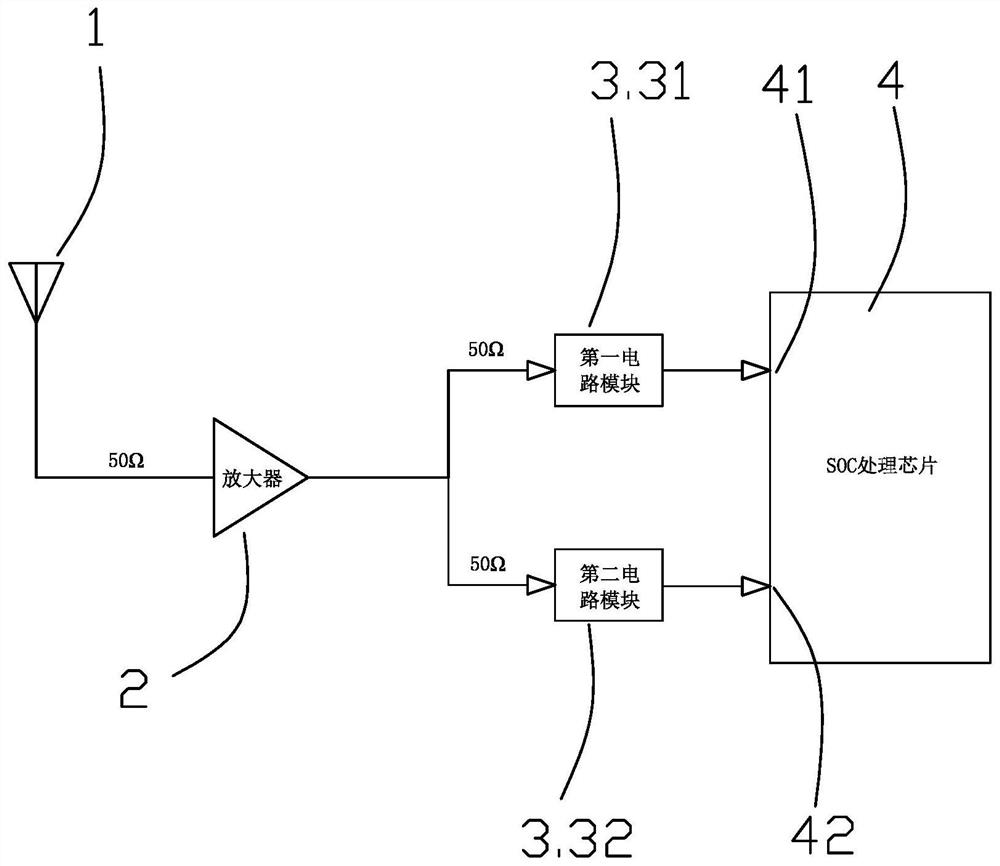A RF front-end structure applied to GNSS dual-frequency receiver
A radio frequency front-end and receiver technology, which is applied in the field of radio frequency communication, can solve the problems of complex front-end structure and cost increase of GNSS dual-frequency receiver, and achieve the effects of reducing area, improving performance and reducing cost
- Summary
- Abstract
- Description
- Claims
- Application Information
AI Technical Summary
Problems solved by technology
Method used
Image
Examples
Embodiment 1
[0026] In this embodiment, a radio frequency front-end structure applied to a GNSS dual-frequency receiver, such as image 3 As shown, it includes a dual-frequency antenna 1, a broadband low-noise amplifier 2 and an SOC processing chip 4. The dual-frequency antenna 1 is connected to the input terminal of the broadband low-noise amplifier 2, and the output terminal of the broadband low-noise amplifier is divided into two branches. After being connected to the circuit module 3, they are respectively connected to the radio frequency input terminals of the SOC processing chip 4.
[0027] Dual-frequency antenna is an antenna specially used to receive dual-frequency signals. It has two working frequency bands and can simultaneously receive GNSS high-frequency band signals such as GPS L1 and BDS B1 and GNSS low-frequency band signals such as GPS L2 / L5 and BDS B2 / B3. Signal, the dual-frequency antenna includes an antenna output port with an impedance of 50Ω, and the dual-frequency anten...
Embodiment 2
[0038] This embodiment presents the second RF front-end structure applied to GNSS dual-frequency receivers. In order to target SOC processing chips of some special GNSS receivers, the front-end structure is modified and deformed. like Figure 4 As shown, the difference from Embodiment 1 is that the SOC processing chip in this embodiment only includes a first RF input port 41 with a characteristic impedance of 50Ω. In order to obtain performance optimization, the first circuit module and the second circuit must be used The module pre-processes the signal. When only the SOC processing chip has only one first radio frequency input port, a power combiner 5 is added behind the first circuit module and the second circuit module. The radio frequency output end of the first circuit module and the radio frequency output end of the second circuit module are respectively connected to the input end of the power combiner, and the output end of the power combiner is connected to the first r...
PUM
 Login to View More
Login to View More Abstract
Description
Claims
Application Information
 Login to View More
Login to View More - R&D
- Intellectual Property
- Life Sciences
- Materials
- Tech Scout
- Unparalleled Data Quality
- Higher Quality Content
- 60% Fewer Hallucinations
Browse by: Latest US Patents, China's latest patents, Technical Efficacy Thesaurus, Application Domain, Technology Topic, Popular Technical Reports.
© 2025 PatSnap. All rights reserved.Legal|Privacy policy|Modern Slavery Act Transparency Statement|Sitemap|About US| Contact US: help@patsnap.com



